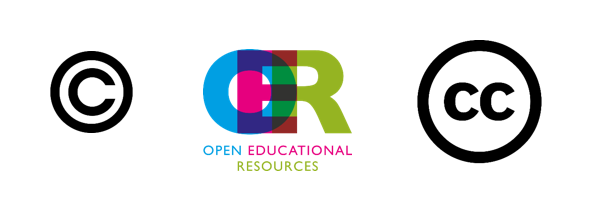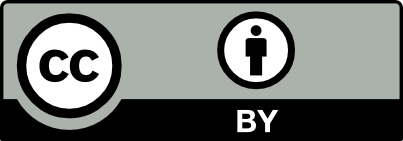Général
FAQ auf Deutsch ansehen.

CC licences from CreativeCommons.org are open licences with which authors grant users the right to
CC-licensed materials are also copyright protected. The conditions
specified in the licence texts must therefore be complied with. Such conditions
include naming
Video: Using images under a free licence – common errors and how to avoid them (in German only)
* Does not apply to works that have ND (no derivatives) in the licence designation.
  |
CC0 |
 |
CC-BY |
 |
CC-BY-SA (share alike) |
 |
CC-BY-NC (non-commercial) |
 |
CC-BY-NC-SA |
 |
CC-BY-ND (No Derivatives) Allowed: commercial use |
|---|---|
|
CC-BY-NC-ND |
Even if works
are found freely online, they are generally copyright protected and cannot be
distributed without the consent of the authors. (A label like the © symbol or a text note such
as “All rights reserved” is not needed to indicate that the content is
protected.)
Open licences allow for the use, adaptation and distribution of copyright
protected material without having to check with the authors. This is
particularly crucial if you want to publish your materials, for example:
Switch OER is a portal for OER materials of Swiss higher education insitutions, which was launched in 2024. All ZHAW OER materials can be found on Switch OER.
Educational materials from all German-speaking countries can be found at oersi.org.
CreativeCommons lists further search tools for various types of media such as images, icons, videos, audio, courses and other educational materials.
Which CC
licences you are allowed to combine in a work depends on whether the works
remain clearly distinguishable from one another or are inseparably merged to
produce a new work. A differentiation is made between the following:
1 a) Compilation of third-party materials
1 b) Integration of materials within your own contents
2. Merging
To comply with the licensing requirements of CC-BY licences, attribute the used materials according to the TULLU rule (referred to as TALLO in English). Include the:
Example:
How to read an academic journal article? by Charlotte Hartwright (as
at 5 April 2017) under CC BY 4.0, video shortened
and adapted with interactive content by Pascal Meier / ZHAW, Social Work (as at January 10, 2025)
Wherever possible, place the licence designation directly at the materials used (e.g., underneath the image). If this isn’t possible, the reference should be made as close to the work as possible (e.g., attribution list at the end of a video). The order in which the details are entered does not matter. Citations in
academic texts can, for example, also follow common citation styles if all of
the aforementioned details are provided in the citation. Further information: Information sheet on CC licences and publishing OER at the ZHAW. See also the "Best practices for attribution" page for further details.
TALLO refers to
a rule for the labelling of openly licensed works as follows:
T: Title
A: Author
L: Licence
L: Link to the licence text
O: Origin (link)
Where possible, also state:
Example:
How to read an academic journal article? by Charlotte Hartwright (as
at 5 April 2017) under CC BY 4.0, video shortened
and adapted with interactive content by Pascal Meier / ZHAW, Social Work (as at
January 10, 2025)
The order in which the details are entered does not matter. Citations in
academic texts can, for example, also follow common citation styles if all of
the aforementioned details are provided in the citation.
The order in
which you provide the information does not matter. Citations in academic texts
can, for example, also follow common citation styles if all of the elements
required under the TALLO rule are provided in the citation:
T: Title
A: Author
L: Licence
L: Link to the licence text
O: Origin (link).
CC0 licences and
other licences of free image databases like Pixabay, Pexels, or Unsplash do not require copyright attribution.
Nevertheless, it is advisable to name the source and a link to the
original.
The license condition "Non Commercial" is not as easy at it looks at first glance.
The ZHAW Open Educational Resources (OER) Policy recommends that all
employees publish teaching materials under an open licence.
Nevertheless, please consider the FaHG
law governing the Zurich universities of applied sciences and arts (§16 a.
(1)) in which it is specified that the rights of use for copyright protected
works that you create in performing your official activities lie with the
university. While the rights of use remain with the ZHAW upon publishing such a
work under a CC licence, a corresponding order or permission from your line
manager is still required. For reasons of proof, you should keep the written
confirmation of consent (e.g. e-mail).
Please also be sure to consider the personal rights of the depicted individuals
who must provide their written consent to publication under a CC licence.
The ZHAW Open Educational Resources (OER) Policy recommends licensing under:
If you would
like to specify further restrictions (non-commercial, no adaptation), use the CC licence chooser to determine your licence. The license chooser guides you step by step through queries to the right Creative Commons license for your needs.
You can then download the Creative Commons license icon and apply it to your work. This alone is needed to put the work under a Creative Commons license and thus publish it as OER. It is not necessary to register your work with Creative Commons or anything the like. The use of Creative Commons licenses is free of charge.
At the beginning or end of your work, include the following:
Place the license in the work itself, e.g. at the beginning of the video the licence icon and at the end of the video the full credit, not just on the platform itself where you upload the work. For a podcast a spoken license statement can be included at the beginning. This way, the license is included when third parties download and use your work.
Where it is not possible to place the license
directly in the work, e.g. in the case of images, it should be located as close
to the work as possible.
For more information, please see: Information sheet onCC licences and publishing open educationalresources (OER) at the ZHAW
You can download all CC icons here free of charge and without having to register and subsequently use them.
If you have the option to integrate an HTML code into your work (e.g. in a website, a blog or on Github etc.), download and integrate the CC icon as HTML code from the license chooser for machine readability.
A licence cannot
be revoked if a work has already been distributed by others under this licence.
Even if you would like to remove a licence or remove CC-licensed material from
the network, the licence remains valid in the material that has already been
distributed by others. This means that a CC-licensed work can continue to be
distributed in the network even after having been removed from the network by
the author.
If you distribute materials yourself that are under a CC licence, you cannot
subsequently be prohibited from making use of these.
CC-licensed
works remain copyright protected. They may only be distributed within the scope
of the licence conditions. This means, for example, that correct attribution is
required for the use of CC-licensed works.
Always adhere to the licence requirements in order to ensure you do not breach
copyright when using CC-licensed material.
Video: Using
images under a free licence – common errors and how to avoid them (in
German only)